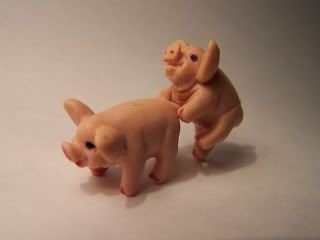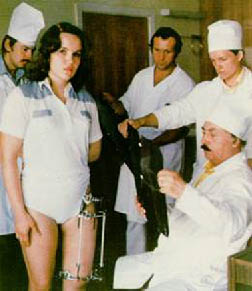 Pass the Pigs
Pass the Pigs, has gone digital. You can play the game online now, though it's not quite as satisfying clicking a mouse as it is physically tossing the little piggies. Incredibly, if you toss a
Makin Bacon, you loose all of your points.
Where was I going with that . . .
My vegetarian friends might want to skip this post.
A friend and I made home cured bacon a few weeks ago. The recipe is from,
Saveur. Prior to seeing the recipe it never even occurred to me that one could make their own bacon. It turns out that bacon is pretty easy to make. First, you'll need to secure some pork belly. After a little poking around we found the pork belly at a butcher shop in the,
Los Angeles' Farmes Market. A butcher at one of the shops that didn't carry pork belly (they offered to order it for us) was skeptical. He said, "I've been cutting meet for 40 years. Started out at Dennis & Dennis in Ohio. You can't make bacon without smoking it." The butchers at the shop where we got the pork belly kept trying to get us to buy their pre-made Belgian Bacon, though oddly they kept referring to it as Danish bacon. They didn't seem to get that the whole idea was to make your own bacon. The pork belly was about $4.30 a pound. It was frozen, so we thawed it in a water bath.
The next step is to grind up the seasonings and rub down the the entire slab. Since we were novices, we followed the Saveuer spice rub recipe exactly. Feel free to experiment with the spice mixture though. After rubbing down the pork, put the slabs into ziploc bags and place them on sheet tray.
The slabs need to cure in the fridge for a week. Flip them every two days. Caress them a little if you want to. My partner even named them. You'll notice sweat in the bag, that's normal, it's just the moisture being drawn out of the pork.

Here's the pork belly after seven days in the fridge.

Give the slabs a bath, washing off all of the spice rub.

My partner in crime. "We wants it, we needs it. Must have the precious."

The proud chef just prior to baking the pork belly.
Bake at 200 degrees, until the internal temperature of the bacon reaches 150 degrees. This took about two hours. The recipe doesn't say whether to cook the pork belly skin side up or down. We went with the skin up, under the theory that some of the fat would drizzle down through the slab.

There was a lull in the action while we waited for the bacon to reach temperature. Here I am doing my best,
Madam Trash Heap. Take your bacon seriously but not yourself.

Behold bacon! We're almost done.

Apparently, it's good luck if you eat the nipple. Sort of like chomping on the baby from a King Cake.

Side view.

Trim the skin and reserve. We'll be returning to that bit of goodness later.

Slice the bacon to desired thickness, chill until cool, fry and consume. For round one we skipped the chilling. We had already endured a week or waiting. Everyone has their preferred technique for cooking bacon. I use a cast iron pan on low heat, just like mom taught me.

Saveur made no mention of what to do with the skin once it was removed from the slab. I thought it would be a shame to just throw it away. Eureka! We decided to make crackling aka pork rinds. Cut the skin into small pieces and season with salt & pepper. Bake at 375 degrees for about three hours. By the way, those are split andouille sausages with bacon on the top rack.
The bacon was delicious, some of it even made it onto the Thanksgiving turkey. Home cured bacon tastes much more like a pork chop than the store bought variety. It's hard to go back to Oscar Meyer after the home grown.
Makin' bacon sparked my interest in Charcuterie. I asked Santa to bring me the bible,
Charcuterie: The Craft of Salting, Smoking, and Curing, for Christmas. Check out the author Michael Rulhman's blog,
Notes from the Food World. I can already see salted meats hanging from the rafters in my apartment. The ultimate goal being homemade prosciutto.



























